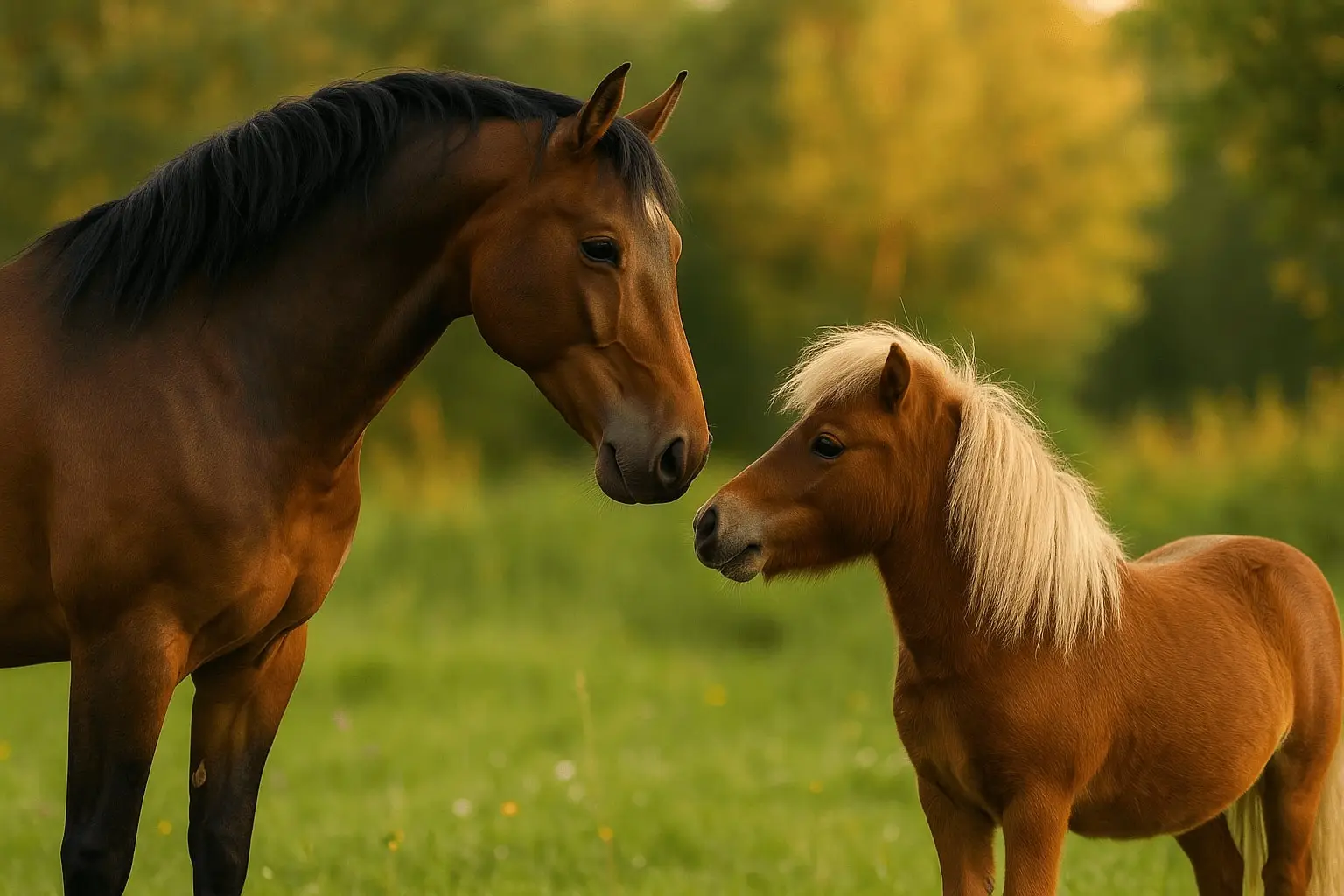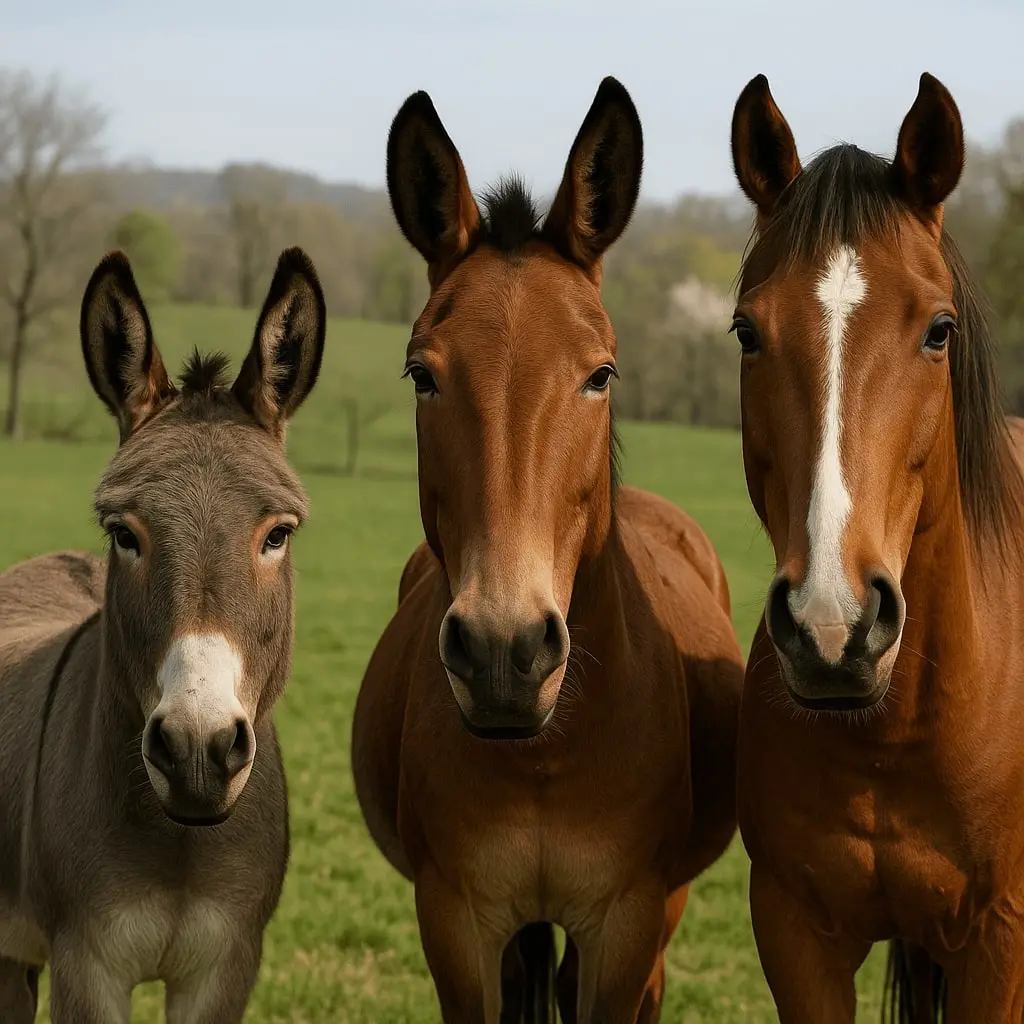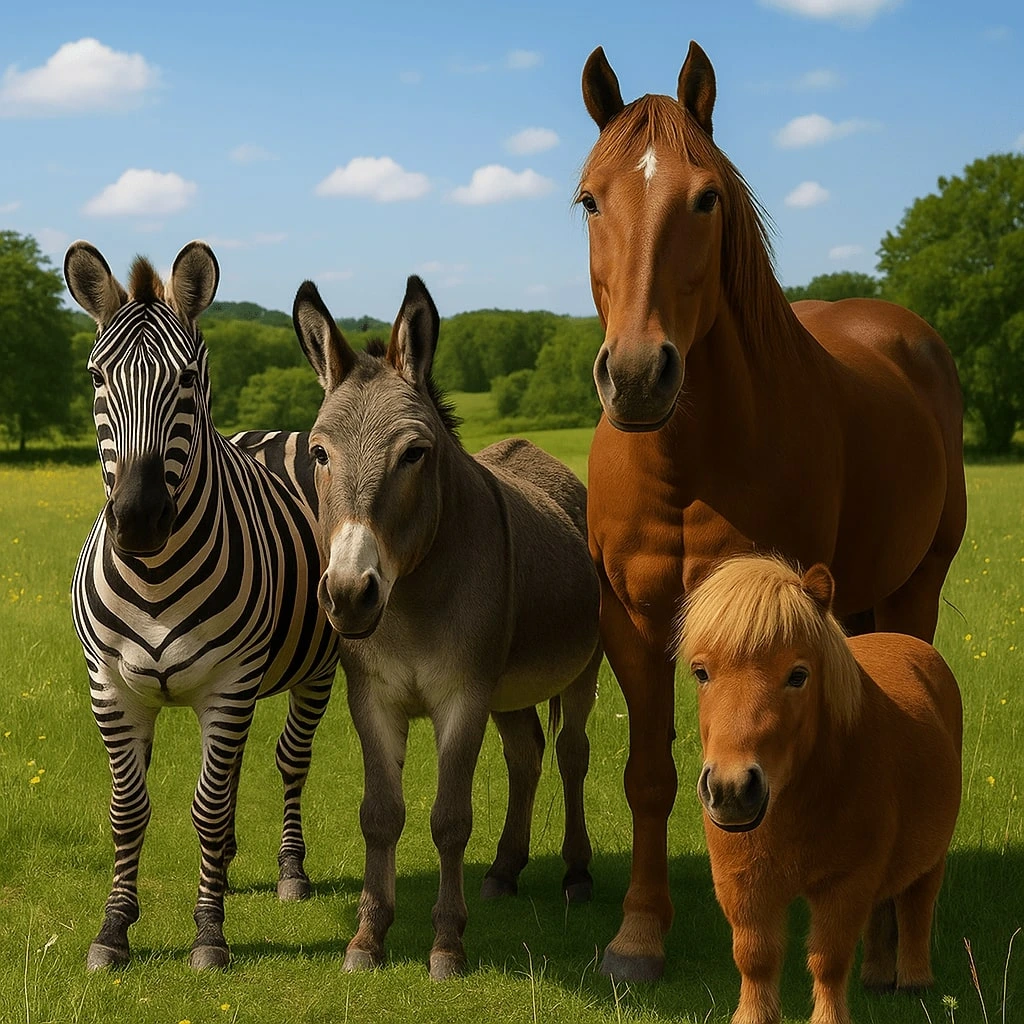Pony and Horse are related but not identical. Both are equines (member of species Equus caballus). At first glance, a pony looks like a small horse, but experts say the two have many real differences. The main difference between horse and pony is size: typically, ponies stay under 14.2 hands (about 58 inches) tall, while horses grow taller. But there is more to it than just height. In this article, we will explain Pony and Horse in simple terms. We cover definitions, body and behavior differences, uses, care needs, 20 key distinctions, a summary table, FAQs, and more. The goal is to be clear and helpful for readers curious about horse and pony differences and to use up-to-date expert info and facts.
What Is a Horse?

A horse is a large, full-size equine animal. Horses usually stand over 14.2 hands tall (a hand is 4 inches) at the withers (shoulders). That is roughly over 58 inches or 4 feet 10 inches tall. Horses have long legs, strong bodies, and a sleek coat. They are built for speed, endurance, and strength. Many horse breeds (like Thoroughbreds, Quarter Horses, Arabians) are known for their athleticism. People use horses for riding, sports (such as racing, jumping, dressage), farm work, transportation, and other jobs. In history, horses pulled plows and carriages and even carried people into battle.
Many horses are bred to be tall and fast. For example, a 16-hand Morgan horse in the image below is well above the pony height limit (he would be called a horse). Horses often have fine coats and long, slender necks. They usually have quieter temperaments, which can make them easier for beginners.
Overall, think of a horse as a big, mature equine animal with a lean build and long legs. Horses come in all colors and breeds, and they have been partners to people for thousands of years.
What Is a Pony?
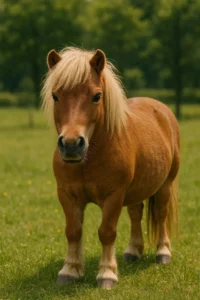
A pony is a small horse-like equine. By rule of thumb, a pony is under 14.2 hands tall at the shoulder when fully grown. This means ponies stay small their whole lives. A pony’s body looks like a miniature horse, but with some key differences.
Ponies tend to have stocky bodies and shorter legs. They usually have thick coats, manes, and tails, which help them stay warm in cold weather. Their bones are often heavier and their necks are thicker in proportion to their body. In winter, a pony’s coat grows even thicker; it often does not shed its winter coat until very late in spring. Because of these traits, ponies are hardy and adapted to tough climates.
Even though a pony looks like a “mini horse,” it’s important to know ponies are not baby horses. A pony is a fully grown adult, just small. (A baby horse or pony is called a foal.) Ponies have their own unique temperament and build. For example, one equine expert notes: “Ponies have a different temperament and sturdier builds than most full-size horses”.
Many pony breeds (like Shetlands, Welsh ponies, and Icelandic horses) fall into this category. Some of these, like the Icelandic Horse, are technically called “horses” by their owners, but they are still under 14.2 hands and have pony-like features. In general, remember: ponies are small, hardy, stocky equines that stay compact even as adults.
Difference Between Horse And Pony
Anatomy and Size Differences

The most obvious difference between horse and pony is size and shape. Ponies are shorter and heavier in build. Here are some anatomical contrasts:
- Height (Size): Ponies are under 14.2 hands (about 58 inches) tall; horses are over that height. This is the standard cutoff used by most riding and show rules. In some cases (like with miniature horses or certain breeds), an equine under 14.2 hands might still be called a horse by tradition. But generally, if it’s under 14.2 hands at maturity, it’s a pony. For example, Shetland ponies are usually well under this height, while a full-sized Thoroughbred is much taller.
- Body Build: Ponies have a compact, stocky body. They have broad chests, short strong legs, and heavy bones. Horses have a leaner, more elongated body. They have long legs, a longer neck, and finer bone structure. In other words, horses look more lanky while ponies look more chunkily built.
- Head and Neck: Pony heads are often shorter with a thicker neck. A pony’s forehead may appear broad, and its muzzle shorter, compared to many horses. Horses tend to have longer faces and slimmer necks.
- Legs and Feet: Ponies’ legs are usually thicker and shorter. Horses have longer legs that help them run faster. Ponies also often have tougher hooves. Their hooves can handle rough ground well. Many pony owners do not need to shoe a pony as often as they would a horse, because the hooves are strong. However, both ponies and horses need regular trimming or shoeing by a farrier.
- Coat and Hair: Ponies almost always have thicker fur. They often grow a heavy winter coat and thick long mane and tail hair. This keeps them warm in cold weather. Horses usually have a smoother, sleeker coat and thinner mane and tail hair. In winter, some horses grow longer hair, but not as thick as ponies. The extra fluff on ponies means they need more grooming (more on that in Care below).
- Bone Structure: Ponies have heavier bones. Their leg and shoulder bones are often broader in diameter. This makes them strong for their size. Horses have lighter, longer bones suited to speed.
Despite these differences, remember that all Pony and Horse are the same species, Equus caballus. Some small horses (like the Miniature Horse or Icelandic Horse) are under pony height but are still called horses by their breed organizations. Likewise, a few ponies (like some Welsh ponies) can grow just above 14.2 hands but are still classed as ponies. But in general, the size and proportions above are a reliable way to tell them apart.
Behavior and Temperament Differences
Pony and Horse often behave differently. Each has traits that can make them better for certain people or tasks.
- Temperament: Ponies are frequently described as smart, bold, and sometimes stubborn. Many pony riders say ponies have big personalities. They can be very clever and wily – for example, they might figure out how to open a latch on a gate or find a hidden stash of treats. Spruce Pets notes that ponies “tend to be more stoic and intelligent than larger horses” and can be “quite wily”. In practice, that means ponies often have a mind of their own. A pony might choose not to do a task if it doesn’t want to.
In contrast, horses are generally more even-tempered and obedient. Many horse breeds have been bred for calmness or cooperation (such as those used for therapy or police work). Horses can still be energetic or nervous, but overall they tend to follow commands more readily than ponies. Bayequest describes horses as typically “gentle” and “cooperative,” whereas ponies are “spirited, mischievous, and independent”. - Energy Levels: Ponies are usually very sturdy and can have plenty of energy. They enjoy working and playing, but because of their smaller size, they tend to move slower than horses. Horses, with their long legs and lean build, are made to gallop and sustain high speed. This means a horse often has more raw power in a short burst (like sprinting) and can cover more ground quickly, while a pony may conserve energy over a longer time at a steadier pace.
- Strength and Willpower: Interestingly, ponies have a reputation for being strong-willed. They will try to avoid work if they can. One writer jokingly notes that ponies are “very adept at avoiding work and withstanding the consequences”. This stubborn streak means that while a child might handle a gentle pony, an inexperienced rider might find the pony tricky if it decides not to cooperate.
- Intelligence: Both Pony and Horse are intelligent, but ponies often show their smarts in mischievous ways. For example, many pony owners learn that a pony can quickly figure out treats or how to manipulate gates. Bayequest notes ponies as “bold and cheeky; quick thinkers”. Horses, meanwhile, are trainable and smart but are generally bred for sport or work and often have a calmer thought process.
- Trainability: Horses can often be easier to train for complex jobs because of their steady temperament. Ponies, while intelligent, might require a firmer or more patient handler because of their stubbornness. Many trainers say it’s sometimes easier to find a quiet horse for a child than a quiet pony, despite ponies being smaller.
In summary, pony behavior: spirited, clever, and independent; horse behavior: calm, cooperative, and steady. These are general trends – individual animals vary. But knowing this helps riders and caretakers choose the right animal for their experience level.
Uses and Activities
Pony and Horse have been used for many of the same purposes over history, but some uses suit one better than the other:
- Riding (Who Rides Them): Ponies are often the first mounts for children and beginners. Their smaller size makes them less intimidating for a small rider. Pony Clubs and riding schools typically use ponies for kids (often called “lead rein” or beginner ponies).
Horses are used by riders of all ages, especially adults or experienced riders. Big horses carry heavier weights safely, so adults tend to ride horses for trail riding or sports. - Sports and Competitions: Horses excel in speed and jumping sports. The fastest racehorses, show jumpers, and eventers are almost always full-size horses. Their long legs and athletic build give them a longer stride for galloping. For example, top racehorses like Thoroughbreds are tall and built for speed.
Ponies can also compete, but typically in their own classes or events designed for ponies. There are pony races and pony jumping classes, but the top speeds are lower due to their shorter legs. Ponies also often excel in events like driving (pulling carts or carriages) and gymkhana games for kids. - Work and Farming: Both animals can do work, but traditionally in different settings. Large horses (like draft horses) were used to plow fields and pull heavy farm equipment or carriages. A single Percheron or Clydesdale (huge draft horses) could pull very heavy loads above ground.
Ponies have also been work horses, especially when size is a factor. Historically, ponies were used as pit ponies in coal mines to haul small carts of coal. One source notes that in late 1800s Alberta, as many as 80 ponies worked in a mine pulling five fully-loaded coal carts at a time. Their compact size let them navigate tunnels where larger horses could not. Ponies have also been used on smaller farms to pull plows or wagons, particularly in hilly or rough terrain. - Recreation and Therapy: Horseback riding for fun, such as trail riding or camping, can be done on both. Big horses can go farther with heavier riders. Ponies are great for pleasure riding by kids. Both Pony and Horse are used in equine therapy programs. Because ponies are smaller, they sometimes help shy or very small children engage with riding. Horses (especially calm breeds) are used widely in therapeutic riding for various ages.
- Ranch and Herding: On ranches and farms, larger horses often herd cattle because they can cover ground quickly. Ponies occasionally help herd small animals like sheep (the Exmoor Pony is sometimes used for this in the UK), but it is more common to see ponies carrying supplies or kids on the farm rather than rounding up cattle.
In short, horses are typically chosen for speed, height, or heavy tasks. Ponies are chosen for kids, smaller-scale work, or whenever a smaller, sturdy animal is enough. Both are useful and valued animals but in slightly different ways.
Care and Maintenance Differences
Taking care of a pony vs. a horse is mostly similar, but there are key differences:
- Diet and Feeding: Ponies eat much less than horses. A common guideline is that horses need about 1.5–2.5% of their body weight in forage (hay or grass) per day, while ponies only need about 1–2%. In simple terms, a 1,000-pound horse might eat 15–25 pounds of hay daily, but a 500-pound pony might need only 5–10 pounds. Because ponies gain weight very easily on too much rich food, they are called “easy keepers”. That means even a small amount of lush grass or grain can fatten a pony quickly.
This difference has a big care implication: Weight management is crucial for ponies. Overfeeding a pony can lead to obesity and serious problems like laminitis (a painful hoof condition). In fact, experts warn it’s very easy to overfeed a pony: “Ponies can eke out nutrition from a pasture that a horse would starve on,” and most ponies will “put on weight just looking at the grass”. In contrast, many horses are “hard keepers” that need more feed to stay healthy. So as a rule: feed a pony less than you would a horse of similar build. Work with a vet to find the right diet. Horses often need supplemental grain for energy (especially if working or competing), while ponies often do fine on good hay and possibly a ration balancer (a feed with vitamins/minerals but lower calories). Always monitor a pony’s weight and keep it trim. - Grooming and Coat Care: Ponies have thicker coats and long manes/tails, so they need extra grooming. A thick pony coat can hold mud and traps ticks or lice more easily. Grooming a pony usually means more brushing to remove debris. You may need to braid a pony’s mane or tail to prevent tangles. Also check under the coat regularly for parasites. Horses have finer hair and usually shed more completely in spring, so grooming a horse is often a little easier. However, all equines need routine grooming, but expect to spend more time with a shaggy pony.
- Hoof Care: Both Pony and Horse need their hooves trimmed every 4–8 weeks by a farrier. Ponies’ hooves tend to be very tough naturally, so many pony owners leave their ponies barefoot (no metal shoes) unless the pony has a specific need or works on hard ground. Horses often wear horseshoes, especially if ridden frequently on rocky or paved surfaces, to protect their hooves.
- Exercise and Space: Ponies can get plenty of exercise just by grazing and moving around a smaller area, since they need less food. Horses, being larger, may need more space and structured exercise (turnout in a field, riding, or lunging) to keep them fit.
- Health Issues: Both animals need veterinary care, but common issues differ slightly. Because ponies are easy keepers, they are more prone to metabolic diseases related to weight. For example, equine metabolic syndrome (EMS) and Cushing’s disease (both linked to obesity and insulin issues) are more common in overweight ponies. Laminitis (founder) is also a big risk if a pony overeats sugar (in grass or grain). Horses, depending on breed, may have breed-specific issues (such as Arabian genetic conditions or draft horse blood disorders), but generally horses as a group do not get as fat as ponies do. Both need regular deworming and vaccinations, but ponies especially should be watched for signs of weight-related problems.
- Lifespan: Ponies often live longer than horses. With good care, many ponies can live into their 30s or even 40s, whereas the average horse lifespan is about 25–30 years. This is like how small dog breeds often live longer than big dog breeds. Owners of ponies should be prepared for a very long companion.
Overall, caring for ponies and horses follows the same basic equine principles (good shelter, water, vet care, etc.), but ponies typically require less food and more attention to weight. They also need a bit more grooming time. Good handlers know these care differences and plan accordingly.
20 Key Differences Between Horse and Pony
Here are twenty clear differences between Pony and Horse. Each point highlights a key trait:
- Size/Height: Ponies stay small. By definition, adult ponies stand under 14.2 hands (about 58 inches) at the shoulder, while adult horses stand taller than that.
- Body Build: Ponies have stocky, sturdy bodies with thicker bone structure. Horses have leaner, longer bodies and limbs.
- Leg Proportion: A pony’s legs are shorter and heavier for its size. A horse’s legs are longer in proportion to its body, suited for running.
- Neck and Head: Ponies often have thick necks and short heads. Horses have slimmer necks and longer faces.
- Coat and Hair: Ponies grow thicker coats, and have fuller manes and tails. Horse coats are usually sleeker, with finer mane and tail hair.
- Bone Density: Ponies have heavier-boned legs and joints. Horses’ bones are lighter to aid speed.
- Temperament: Ponies are known to be bold, intelligent, and sometimes stubborn. Horses are generally gentler, calmer, and more trainable.
- Stubbornness: Ponies can be more mischievous or willful. For example, they may cleverly avoid work or sneak treats. Horses are usually more straightforward in behavior.
- Energy & Speed: Ponies are strong for their size but usually slower. Horses have greater speed and endurance over long distances.
- Strength: Relative to body weight, ponies are very strong. They can often pull or carry much heavier loads than you’d expect for an animal their size. Horses have strength, too, but mostly in absolute terms due to their bigger size.
- Hardiness: Ponies are hardy in tough climates. They tolerate cold weather well due to thick coats and can survive on sparse pasture. Horses generally require more shelter and good feed.
- Metabolic Rate: Ponies have a slower metabolism. This means they need less food, but also that they can easily become overweight (and risk laminitis). Horses have a faster metabolism and often need more feed, especially if working.
- Lifespan: Ponies often live longer. It’s common for ponies to reach 30–40 years old. Many of the oldest recorded equines are ponies. Horses more typically live to around 25–30 years.
- Maturity Rate: Pony foals often reach their adult height faster than horse foals. (However, some sources say horses mature mentally sooner, so growth vs. behavior maturity can vary by breed.)
- Uses: Ponies are often used for children’s riding, small-scale farming, driving carts, and riding lessons. Horses are used for racing, jumping, dressage, police work, large-scale farm work, and rides for adults.
- Behavior with Children: Ponies are smaller and feel safer for kids, but their independent nature means not all ponies are gentle. Horses can be chosen for a very calm temperament for beginners.
- Diet Needs: Ponies require less food and often need a restricted diet (they are easy keepers). Horses need more calories, especially if ridden or working.
- Grooming: Ponies need more grooming for their heavy coat. They may need mane/tail braiding and parasite checks. Horses need regular grooming too, but with typically less fur it can be easier.
- Classification: Height rules can blur. Some small horses (like American Miniatures or Icelandic Horses) fall under pony height but are still called horses by tradition. Likewise, all polo ponies are called ponies even if some are full-size horses. In short, pony vs horse is sometimes a matter of breed and naming tradition.
- Not Baby Horses: Importantly, a pony is NOT a baby horse. Both are adults of different sizes. A baby (young) equine of any kind is called a foal. Saying “pony” when you mean “baby horse” is incorrect.
Difference Between Horse And Pony
These differences cover anatomy, behavior, uses, and care needs. Despite all these distinctions, Pony and Horse share many similarities (same biology, diet types, social behavior, etc.). But each bullet above highlights a way in which pony and horse differ.
Horse vs Pony: Comparison Table
| Feature | Pony | Horse |
| Height | Under 14.2 hands (under ~58 inches) | Over 14.2 hands (taller) |
| Body Build | Stocky, compact, heavy-boned | Leaner, longer legs and neck |
| Legs | Shorter, thicker legs | Longer, more slender legs |
| Coat & Hair | Thick coat; long mane and tail | Sleeker coat; thinner mane and tail |
| Strength | Very strong for size | Strong overall; built for larger tasks |
| Speed | Generally slower, steady pace | Faster top speed; excels in racing |
| Temperament | Bold, smart, often stubborn | Gentle, calm, cooperative |
| Uses | Children’s riding, driving carts, small farm work | Racing, show jumping, dressage, heavy farm work |
| Diet | Eats less; easy keeper (gains weight easily) | Eats more; higher calorie needs |
| Grooming | Needs extra grooming for thick coat | Needs standard grooming (fine coat) |
| Lifespan | Often 30–40+ years | Typically 25–30 years |
| Hooves | Hard hooves; often barefoot | May wear shoes depending on work |
| Breeds | Examples: Shetland, Welsh, Connemara, Icelandic (called “horses” by tradition)【63†L?】 (not cited) | Examples: Thoroughbred, Arabian, Quarter Horse, Draft breeds |
Table: Key anatomy, behavior, and care differences between ponies and horses.
(Note: The height cutoff of 14.2 hands is a general rule. Some ponies may slightly exceed it and some small horses fall below it, based on breed definitions.)
FAQs (Frequently Asked Questions)
Q: Is a pony just a baby horse?
A: No. A pony is a small adult horse, not a juvenile. Both are Equus caballus, but “pony” refers to the adult animal’s type, not its age. A baby horse (of either type) is called a foal, regardless of whether it will grow into a pony or a horse. In other words, ponies never grow into horses; ponies stay ponies and horses stay horses, since their differences are genetic and structural.
Q: What is the size difference between a horse and a pony?
A: The standard difference is height. An equine that is under 14.2 hands (about 58 inches or 4 feet 10 inches) tall at maturity is classified as a pony. If it is 14.2 hands or taller, it is called a horse. (A “hand” is 4 inches.) This size rule is used by horse shows and breed registries, though some places use 14.0 hands. Remember that size is just one factor; some breeds blur the line (for example, the Icelandic Horse averages under 14.2 but is still called a horse by tradition).
Q: Why are ponies so much stockier than horses?
A: Through evolution and breeding, ponies have developed stockier builds. This helps them survive rough conditions. Ponies typically have short, strong legs and heavy bones. This body shape makes them very strong for their size, able to carry heavy loads or pull carts. Horses, on the other hand, were often bred for speed and covering distance, which favors longer legs and a leaner body. The stout pony body also helps them stay warm – they pack on fur and fat more easily, which keeps them insulated.
Q: Are ponies easier to care for than horses?
A: In some ways ponies need less (such as food and space), but they have special needs too. Ponies eat less hay and grain because they are small, but this means you must watch their diet closely. Overfeeding a pony can lead to serious health issues like laminitis. Ponies also require extra grooming because of their thick coats. So “easier” depends on the task. If your barn is set up for horses, managing a pony mostly means adjusting rations and grooming routine.
Q: Do ponies live longer than horses?
A: Often, yes. Smaller animals like ponies tend to have longer lifespans. Many well-cared-for ponies live into their 30s or even 40s. By comparison, the average horse lives around 25–30 years. Part of this is due to their slower metabolism and hardy nature. Good examples are the world’s oldest equines on record – many of them are pony breeds.
Q: Can Pony and Horse interbreed?
No, ponies and horses differ in size, build, temperament, and classification, despite being the same species.
A: Yes. Since they are the same species, Pony and Horse can mate and produce foals. The foal’s size as an adult will depend on genetics: if bred horse-to-pony, the offspring might be pony-sized or horse-sized or in between. However, breeders usually keep ponies breeding with ponies to maintain pony traits, and horses with horses.
Q: Is pony and horse same?
No, ponies and horses differ in size, build, temperament, and classification, despite being the same species.
Difference Between Horse And Pony – In A Nutshell
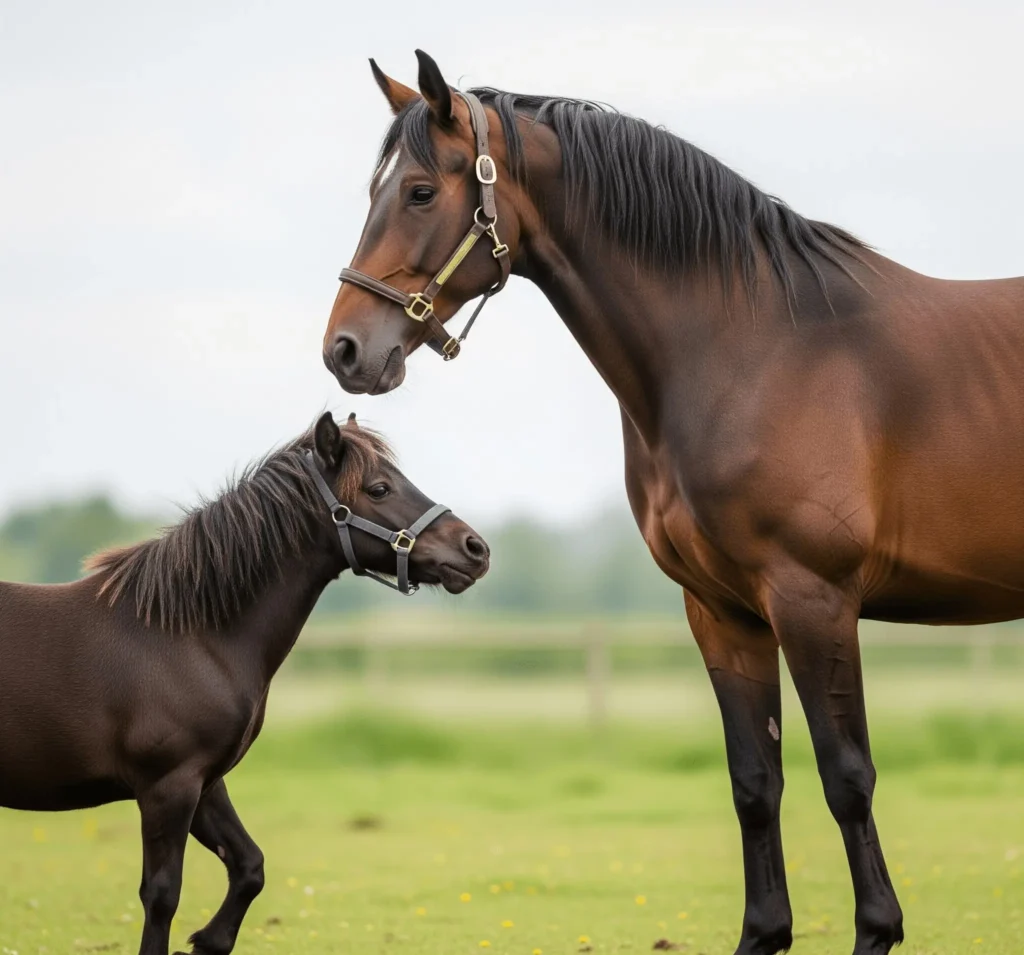
Pony and Horse are close relatives, but if we go horse vs pony, they differ in many ways beyond just height. Ponies are simply small horses, but they have unique builds, personalities, and uses. We’ve seen that ponies are generally shorter, sturdier, and hardier than horses. They tend to be smart, independent, and sometimes stubborn, whereas horses are often gentler and more even-tempered. Ponies require less food but more careful diet management, and they often live longer. In contrast, horses excel in speed and power for racing or work.
Understanding the horse vs pony differences helps caretakers make good choices. For example, a pony might be perfect for a child learning to ride, while an adult may need a horse for certain competitions. Always remember: a pony is not a baby horse – it’s a full-grown equine with its own characteristics.
Both Pony and Horse bring joy and service to humans in different ways. By recognizing their key differences in anatomy, behavior, and uses, we can care for them better and use them for the right jobs. Whether riding a pony down a country trail or cheering on a horse in a race, appreciating each animal’s traits leads to happier, healthier equines.

